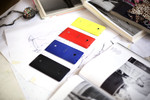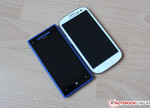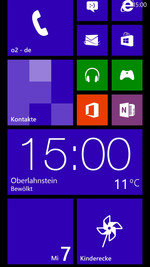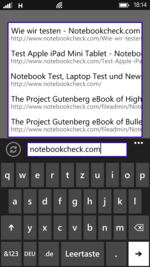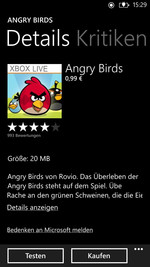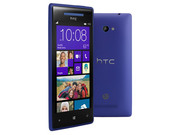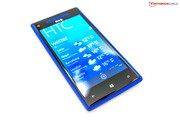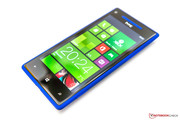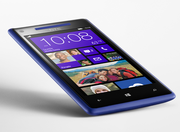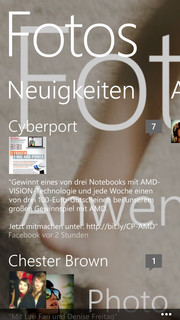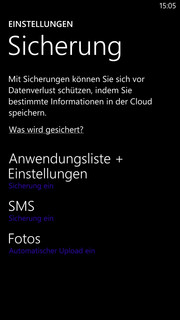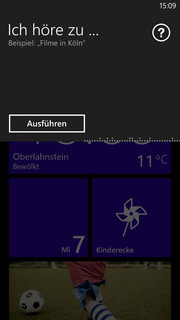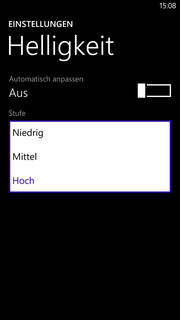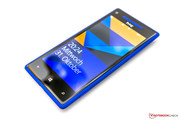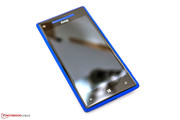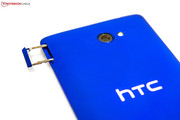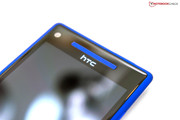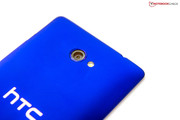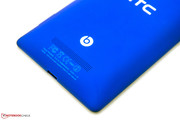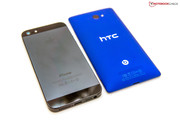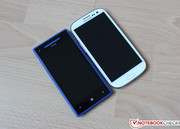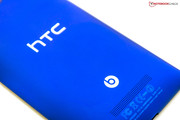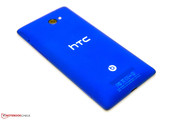Review HTC Windows Phone 8X Smartphone

Microsoft wants to go new ways with its new operating system from Redmond; An OS for computers, tablets and smartphones alike. The Windows Phone 8X by HTC is one of the first smartphones that feature this new software and, in order to present it properly, it naturally needs exceptional hardware. The mix of an IPS touchscreen with a 720p resolution, a Snapdragon S4 SoC (system-on-a-chip) with a clock frequency of 1.5 GHz, 1 GB of working memory and an appealing casing design are to ensure the new operating system's successful kick-off. Other Windows Phone 8 contenders vying for the number one position in the high-end field are Nokia's Lumia 920 and Samsung's Ativ S.
Case
It is not unusual for HTC to use a unibody casing milled from one piece of metal. However, HTC emulates the competition with its Windows Phone 8X and uses matte polycarbonate. The smartphone features a good grip owing to the lightly roughened material. Like HTC's Android-based One X, the battery cannot be replaced. That means there is no battery cover and the internal memory cannot be expanded via a micro SD card. Only the SIM card slot features a maintenance flap that is opened using the same method as known from the iPhone range.
The 8X is currently available in four colors. Owing to the unibody casing, it is very stiff and pressure resistant almost everywhere. We can marginally dent the plastic on the back's center using selective pressure. The main camera is additionally framed in a small metal ring. The build quality and used materials convinced in the test.
The design makes a very consistent impression and looks good. Unlike the design of Apple's iPhone 5, the back is not quite as angular and the sides are rounded. That lets the smartphone fit better in the natural curvature of the palm. Moreover, the Windows Phone 8X features a message LED. Regrettably, it currently only shows activity when the device is connected to the charging cord (red) and lights up green as soon as the battery is recharged. The additional lighting mode could possibly be made available with one of the next software updates.
In a direct size comparison of HTC's 8X (132.4 x 66.2 x 10.2 mm/~5.21 x 2.61 x 0.40 inches) and Nokia's Lumia 920 (130.3 x 70.8 x 10.7 mm/~5.13 x 2.79 x 0.42 inches), we notice that both feature similar dimensions, but exhibit different screen diagonals. The Lumia 920's screen is 0.2 inches bigger than the 8X. HTC's 8X clearly differs from its contender in terms of weight. It is lighter by an impressive 55 grams (~2 ounces). Surprisingly, Samsung's giant, 4.8 inch Galaxy S3 merely weighs 3 grams (~0.1 ounces) more.
Connectivity
The sides of HTC's 8X casing are not packed with ports. There are no ports or buttons on the left. The SIM card tray is at the very top right side and can be opened with a pointy object. The volume control rocker is positioned directly below that. A mechanical button for triggering the camera in the corresponding mode is found at the lower right bottom. As in almost every smartphone, a micro USB port is located on the casing's bottom. It is also used for charging the device. The pressure points of the three physical buttons could not be more different. While the volume rocker responds well to pressure, the camera button is very smooth and does not provide as much feedback. In addition to the power button's somewhat unfavorable positioning, it has a very delayed pressure point, provides almost no feedback and is also a bit stiff. It would make more sense to place this button on the side of such a large device, as seen in Samsung's Galaxy range.
Since the look is not all that counts, we now come to the "inner values". Like in the somewhat larger HTC One X, the buyer regrettably has to live without a micro SD card slot. Why HTC opted against installing a slot for a memory expansion remains unanswered, especially as the much less expensive Windows Phone 8S can accommodate additional micro SD cards. Our device sports 16 GB of internal memory. 14.56 GB are free to use; the rest is reserved for the system. At the time of this review, the 8X was only available with a 16 GB memory. We currently do not have any information whether other memory models are intended.
Communication & GPS
Like other devices in this price range, the Windows Phone 8X scores with an extensive range of communication options. The main component is the installed Wi-Fi module that transmits via the 802.11 a/b/g/n standard. Bluetooth is of course also available, but it is the somewhat outdated 3.1 version. Our test device also features near-field communication (NFC). The smartphone can be used in most global networks since it supports the four main GSM frequencies. It quickly connects to tracking systems due to A-GPS and is also very stable in line of sight.
HSPA+ enables swift Internet connections, whereby a maximum transmission rate of 21 MBits per second are possible. The 8X is not LTE compatible.
Camera
HTC gives its Windows Phone 8 pioneer two cameras. The main camera on the back features 8 megapixels and includes auto-focus, LED flash and a BS sensor for improving pictures in poor ambient light. The lens has an aperture of f2.0 and a focal length of 28 mm. Videos can be made in a Full HD resolution (1080p) in video mode. The camera's technical equipment is virtually identical with Samsung's Galaxy S3 and HTC's One X. The front-facing camera has a maximum resolution of 2.1 megapixels and features an "ultra-wide angle lens" with the same shutter speed as the main camera. It is also possible to shoot videos in 1080p using the front-facing camera.
The main camera in HTC's 8X takes good indoor pictures in moderate light. There is virtually no image noise and the colors look more natural than those of the Galaxy S3. In return, the front-facing camera is much less light sensitive and the picture's motif is not as focused due to its maximum resolution. We see the same effect on outdoor shots taken with the front-facing camera. Outdoor pictures shot with the main camera exhibit good results, although the pictures taken with the Galaxy S3 are a bit more appealing because they seem brighter and the colors are depicted better.
Windows Phone 8
More interesting than the hardware inside HTC's 8X is certainly the completely new software. The metro design of the modern UI surface is known from the previous Windows Phone 7, but it has been completely refreshed. The home screen can be compared with widgets known from Android systems. Applications are continuously updated, are never idle and imply high dynamics. Naturally, the looks can be customized. Interesting features are noticed when scrolling through the innumerable settings. This is Microsoft's attempt at making its new device interesting for company use. The smartphone can be furnished with a corporate account and consequently allows the company to have a better control over its smartphones because highly sensitive data (e.g. email traffic) might be stored on them. Thus, the boss can disable the SD card or delete all data on the device via a remote application.
Another setting is dubbed "Kid's Corner", which enables assigning certain applications, games or videos to a specific target group. It is very obvious that the developers have put a lot of thought into software usability. The entire handling is very intuitive; the functions are easy to understand and are self-explanatory within a short time. Those already using Windows 8 on their computer or tablet will immediately find their way around on the metro design and can get started. The interface for coupling a computer, tablet or smartphone is refined. Synchronizing content via Microsoft's Skydrive cloud service facilitates work and exchange among devices extremely well.
All in all, the system already runs very well and reliably just after its unveiling and is very enjoyable for the user. How the Windows Phone 8 asserts itself against the strong contenders will be seen in the next months. There definitely is potential and Windows' app store is continually being filled with applications and games.
Accessories
A stereo headset (no in-ear headset) as well as a modular PSU with a USB connector is included. Although a Beats Audio logo is printed on the 8X's back, there are no supplies from the company. The battery is built into the smartphone and cannot be replaced. Additional accessories have to be bought separately.
Warranty
HTC includes a 24-month warranty on the 8X and 12 months on the accessories. There are no warranty upgrades available.
Input Devices & Controls
The capacitive touchscreen in HTC's 8X also works very precisely and accepts inputs accurately and without much delay. Multi-touch gestures, such as pinch-to-zoom or tap-to-zoom as known from Google's Android or Apple's iOS, are also supported. The fade-in QWERTY keyboard has been modified compared with HTC's Android default keyboard. For example, it no longer features navigation arrows nor can additional icons be selected by pressing the symbol for a longer time. The opened keyboard takes up roughly 50% of the screen in profile mode - and even more in landscape mode. Unfortunately, there is not yet a setting option for altering the keyboard's design or enabling other features (navigation arrows).
There are three touch-buttons below the touchscreen for navigating throughout the entire Windows Phone 8 world. Actually, two of the keys would have been enough because only one is needed for opening the Internet quick search. The touch-buttons are permanently illuminated when the screen is on. They cannot be completely turned off like in the Galaxy S3. As in HTC's One X, the device cannot be activated by any of the three keys.
Display
The screen diagonal of 10.9 cm or 4.3 inches is nothing special in smartphones anymore. However, the HD resolution of 720p (1280x720 pixels) is impressive. The capacitive Super LCD2 touchscreen is protected by Gorilla Glass 2 and uses the well-known IPS technology. With a pixel density of 342 dpi, it places itself in front of Samsung's Galaxy S3 (306 dpi) and the direct Windows Phone 8 contender from Finland - Nokia's Lumia 920 with a pixel density of 332 dpi.
Our measurements of the screen brightness resulted in a maximum of 318 cd/m² in the upper left area. The average brightness of HTC's 8X is 293.8 cd/m². HTC's One S reached 306 cd/m² and the bigger One X achieves very bright 448.4 cd/m² in this assessment. In another comparison with the One S (95%) and the One X (93%), the Windows Phone 8X only managed a lower illumination of mere 83%. We measured a black value of 0.46 cd/m² and a contrast of 643:1 owing to the IPS technology.
| |||||||||||||||||||||||||
Brightness Distribution: 83 %
Center on Battery: 296 cd/m²
Contrast: 643:1 (Black: 0.46 cd/m²)
The screen's brightness has to be set close to 100% if you want to easily see something on the screen outdoors. Direct sunlight should be avoided because the glossy screen is very reflective. Everything is seen easily on a lightly overcast day.
Performance
HTC wants to see its 8X at the top of Windows Phone 8 devices. Naturally, good hardware equipment is required to win this battle. Like HTC's One S, the 8X uses the power reserves of Qualcomm's Snapdragon S4 MSM8260A clocked with a frequency of 1.5 GHz. The Adreno 225 is used as the graphics card. This SoC is built in a 28 nm manufacturing process. The working memory has a capacity of 1 GB. Nokia's Windows Phone, the Lumia 920, features a very similar hardware configuration (Snapdragon S4 MSM8960 with 1.5 GHz, Adreno 225 and a 1 GB RAM).
We performed various benchmarks to achieve a better comparison basis with other devices. HTC's 8X reached a much higher score than HTC's One S Android counterpart in the synthetic AnTuTu Benchmark v2 (difference approx. 42%). Since they are based on the same hardware, we assume that this performance difference is operating system related. Both browser-based benchmarks Google V8 version 7 and SunSpider 0.9.1 scatter the results in two directions. The One S achieves an 87% better performance than our test device in Google V8 version 7. In return, the 8X outperforms the One S by slightly over 100% in the Java benchmark SunSpider 0.9.1.
| AnTuTu v2 - Total Score (sort by value) | |
| HTC Windows Phone 8X | |
| HTC One S | |
| Samsung Galaxy S3 | |
| HTC One X | |
| Google V8 Ver. 7 - Google V8 Ver. 7 Score (sort by value) | |
| HTC Windows Phone 8X | |
| HTC One S | |
| Samsung Galaxy S3 | |
| HTC One X | |
| Sunspider - 0.9.1 Total Score (sort by value) | |
| HTC Windows Phone 8X | |
| HTC One S | |
| Samsung Galaxy S3 | |
| HTC One X | |
| Browsermark 1.0 - --- (sort by value) | |
| HTC Windows Phone 8X | |
| HTC One S | |
| Samsung Galaxy S3 | |
| HTC One X | |
* ... smaller is better
We performed even more benchmarks for comparing future Windows Phone 8 smartphones and tablets. The benchmark "Free" is similar to Windows' Experience Index in the computer. Different hardware parts are assessed and rated with a number on a scale up to 7.9. The smartphone achieved a rating of 7.9 here. The device achieved 215 ms in the Pi benchmark. In WP Bench Free, the 8X accomplished a rate of 233.5. Multibench 2 is divided into four parts: CPU: 17.635 - data: 24.119 - memory 02.640 - graphics: 38.563. Futuremark's browser-based Peacekeeper achieved a score of 337. In comparison, Apple's iPhone 5 achieved 5907 points, HTC's One S 460 points and the Galaxy S3 680 points.
We also executed a data transmission speed test from a computer to the smartphone. Transferring 10 GB, split up in 20 files with 500 MB each, took 12 minutes and 32 seconds. Full HD videos are also no problem for the multimedia talent. Playing the trailer from the latest James Bond adventure Skyfall is fun because playback is smooth and the colors are authentic. To make sure that this is not an isolated case, we tested the prior result using the Full HD trailer from Transformers 3 - Revenge of the Fallen.
Microsoft's still fairly young app store does not yet have the variety of the App Store or Play Store and thus not as many 3D games with which we can extensively test performance. We found 3D Brutal Chase and could test it online and against other players right away. We come to the conclusion that HTC's 8X provides sufficient reserves to easily render the latest games. Of course the classic game Angry Birds is a must for installing on the 8x.
The abundance of possibilities sometimes lets you forget that the smartphone can also be used for making calls. The speech quality was good at both ends in the many test calls we made. The volume was sufficient to make calls in a car (from the passenger seat). The free-hands feature also did a satisfactory job although the calling partner complained about a slightly low volume.
Emissions
The Windows Phone 8X by HTC is only cooled passively, which in return has a positive effect on noise development. Our measurements showed that 40 degrees Celsius (~104 °F) was only surpassed during full load. We measured the maximum temperature of 43.4 degrees Celsius (~110 °F) directly at the micro USB port. The device's temperature increase is clearly noticed, but we cannot say that it makes use unpleasant. The temperatures almost always remained below 30 degrees (~86 °F) in idle. It only got a bit warmer in the area of the charging port, where we presume the SoC (system-on-a-chip) is located. The PSU heated up to 39.7 degrees (~103 °F) when the device was put under full load and 30.4 degrees Celsius (~86 °F) in idle.
(±) The maximum temperature on the upper side is 43.4 °C / 110 F, compared to the average of 35.2 °C / 95 F, ranging from 21.9 to 247 °C for the class Smartphone.
(±) The bottom heats up to a maximum of 40.4 °C / 105 F, compared to the average of 34 °C / 93 F
(+) In idle usage, the average temperature for the upper side is 29 °C / 84 F, compared to the device average of 32.9 °C / 91 F.
Speakers
HTC places a speaker on the lower back for audio playback. The Beats Audio logo is directly above that. That suggests that the speakers come from Beats Audio. We also find a corresponding field dubbed "Beats Audio" in the menu settings. However, we are quickly disillusioned because Beats Audio is not available for the telephone speaker. That obviously only works when additional hardware is used. Nevertheless, HTC has installed a high-end speaker that is very balanced at higher volumes. The sound does not seem as tinny as in the Galaxy S3. However, the smartphone should not be placed on its back when playing music if at all possible. That partly covers the speaker, which distorts the sound and ruins what is actually good quality audio. The audiophile listener should not expect a full bass sound for construction-related reasons. The included headset provides considerably superior music enjoyment, exhibits more bass and enables the Beat Audio feature as soon as it is inserted.
Battery Life
Power Consumption
The power consumption of various application scenarios is ascertained by using Voltcraft's VC 940 in this section. HTC's 8X consumed between 2.0 and 2.6 Watts in idle. The One S and One X from the same manufacturer consume much less with rates between 0.6 and 1.8 Watts. We measured consumption rates ranging from 3.7 to 5.6 Watts during load. HTC's One X reaches almost the same maximum (5.8 Watts) and Samsung's Galaxy S3 is satisfied with a maximum of 3.4 Watts. Although HTC's One S features the same SoC and screen diagonal as our test device, it has much lower power consumption in all scenarios. We presume that the different operating systems are the reason for the varying power consumption.
| Off / Standby | |
| Idle | |
| Load |
|
Key:
min: | |
Battery Runtime
We recorded a battery runtime of a whole 14 hours and 58 minutes from a fully charged HTC 8X in idle mode using minimum brightness and disabled wireless modules. That is a good rate, although HTC's One S lasted for a full 19 hours without being recharged. The modular PSU needed 3 hours and 1 minute to completely recharge the battery. The 8X is again defeated in the full load test and only lasts for 1 hour and 55 minutes. The One S ran 34 minutes longer despite virtually identical hardware. Both contenders achieved similar times in the more realistic "browsing via Wi-Fi" scenario. With 9 hours and 2 minutes, HTC's 8X almost reached the runtime of the One S (9:40 hours). We could not perform the test using a brightness of 150 cd/m² due to the 8X's screen brightness settings. The Windows Phone only provides three screen brightness levels: low, medium and high. We opted for the medium setting which corresponds to 115 cd/m². Although this made a direct comparison with the One S difficult, it clearly shows that the Android has an even bigger lead than the measured rates attested.
Verdict
The overall impression of the new high-end smartphone based on Windows 8 is positive throughout. The software is dynamic and intuitive in use. Even technically less savvy users will quickly have an overview of the operating concept and the options. The smartphone is in line with other Windows 8 systems, such as a computer or tablet, and allows easy synchronizing via Microsoft's cloud service. Features like the "Company App" for catering to the needs of companies are implemented in the settings. Microsoft has done its homework and is creating a multipurpose tool for computers, tablets and smartphones with its comprehensive Windows 8 system. HTC's 8X provides enough reserves and we never had the feeling that we were facing a performance bottleneck. The IPS screen delivers natural colors and can be used precisely. However, we rate the lack of a micro SD card slot and the built-in battery as negative. But it is not only HTC to accept this criticism. Google's latest Nexus 4 as well as all previous iPhone models also have these two drawbacks.
We will see whether this is a revolution or only an evolution in terms of software in the next months. After all, such an operating system makes or breaks with its additional applications. Microsoft's app store is by far not as well filled as the ones from the competition. But its day may (and must) come. HTC's 8X is an interesting alternative for Android and iOS devices in any event.




